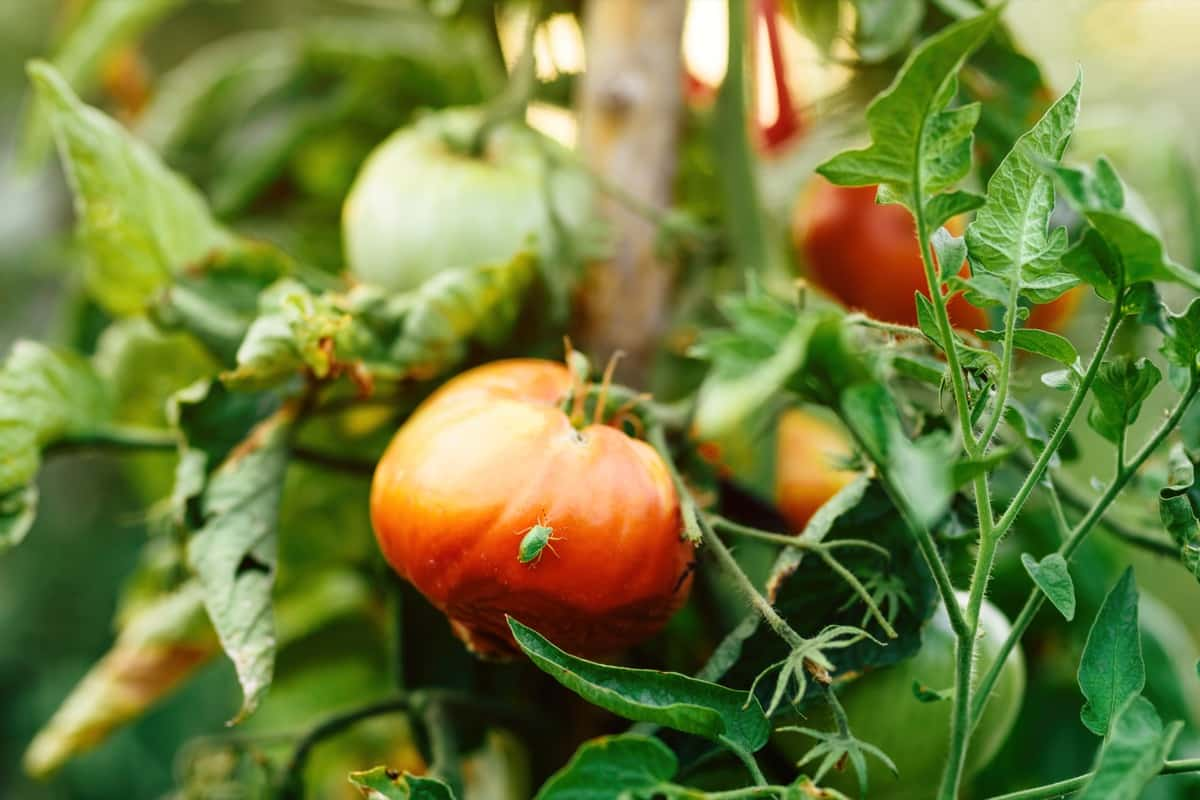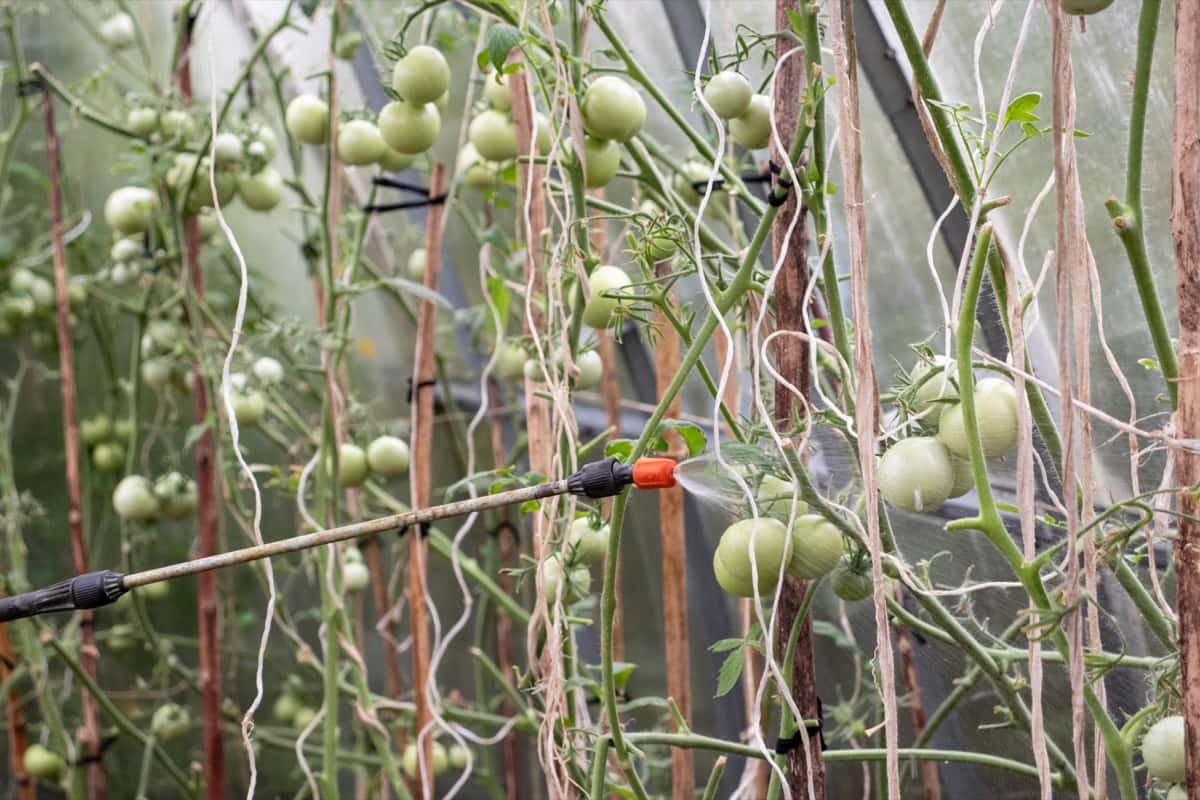Tomato plant pests are tiny intruders that can cause big trouble in your garden. Pests in Tomatoes can wreak havoc on your plants, causing damage to leaves, stems, and even the fruit itself. These pesky bugs affect the appearance of your Tomato plants and can significantly reduce their yield.

Natural Ways to Control Tomato Plant Pests
Natural Ways to Control Aphids on Tomato Plants
- These tiny insects suck sap from the leaves and stem, stunting plant growth and spreading diseases. There are some natural ways to keep bugs off Tomato plants;
- Dish soap – A simple solution to control aphids is spraying water and dish soap onto affected areas.
- Soapy water – Mix dish soap with water and used in a spray bottle and apply it directly onto the infested leaves. The soap will suffocate the aphids and prevent them from causing further harm.
- Neem oil – This plant-based oil acts as a repellent and insecticide, effectively controlling aphids without harming beneficial insects.
- Intercropping – Additionally, intercropping with garlic or chives has been found to repel aphids due to their strong odor.
- Plant inspection – Regularly inspecting your plants for signs of aphid infestation in Tomato plants is crucial in preventing widespread damage or disease transmission among your Tomatoes.
Effective Home Remedies for Tomato Hornworms
- Introduce beneficial insects – Ladybugs and green lacewings are voracious predators of Tomato hornworms and can help keep their population in check. You can attract these helpful bugs by planting flowers such as marigolds or daisies nearby.
- Homemade sprays – One popular recipe involves mixing water with a dish soap and cayenne pepper. This recipe is a deterrent for the hornworms, making them less likely to feast on your Tomatoes.
- Interplanting – Additionally, interplanting with companion plants like basil or garlic have been known to repel Tomato hornworms due to their strong scent.
In case you missed it: How to Pollinate Tomatoes: Are Tomato Flowers Self-Pollinated or Cross-Pollinated?

Organic Solutions for Whiteflies on Tomato Plants
Whiteflies can be a nuisance when they infest Tomato plants, but there are natural and organic solutions to control these pesky pests. One effective method is introducing beneficial insects, such as ladybugs or lacewings, into your garden. These natural predators feed on whiteflies and help keep their population in check.
Another solution is to make a homemade insecticidal soap spray using simple ingredients like liquid dish soap and water. Mix one tablespoon of soap with one quart of water and spray it directly onto the leaves of your Tomato plants. The soap suffocates the whiteflies, making it difficult for them to breathe. Neem oil is another organic solution that can combat whiteflies. Dilute neem oil according to the instructions on the bottle and apply it evenly onto the foliage of your Tomato plants.
By utilizing these organic solutions, you can effectively manage whitefly populations without relying on harmful chemicals or pesticides that may harm beneficial insects or contaminate your produce. Prevention is key for maintaining healthy soil conditions, and providing proper care for your Tomato plants will also help deter whitefly infestations in the first place.
How to Get Rid of Spider Mites on Tomato Plants Naturally
Spider mites can be a pesky problem for Tomato plants. These are tiny pests that feed on Tomato plants’ sap, causing yellow spots on leaves and webbing between branches. There are some home remedies for Tomato plant pests without resorting to harmful chemicals.
- Neem oil – It is derived from the neem tree seeds and has insecticidal properties that repel spider mites. Mix neem oil with water and apply them to your Tomato plants’ affected areas.
- Homemade garlic spray – Crush several garlic cloves and steep them in water overnight. Then strain this mixture into a spray bottle and use it on your Tomato plants. The strong odor repels both spider mites and other unwanted pests.
- Plant inspection – Regularly inspecting your plants for signs of infestation is also essential for early detection and prevention. If you spot any webbing or discoloration on leaves, take action immediately before the infestation spreads.
- These natural methods can eliminate spider mites from your Tomato plants while maintaining an organic garden environment free from harmful pesticides.
Home Remedies for Controlling Cutworms in Tomato Gardens
Create a physical barrier – Take cardboard or paper towel rolls and cut them into small sections. Then, place these collars around the base of each plant, sinking them into the soil slightly. This will prevent cutworms from reaching the stems and damaging them.
Using diatomaceous earth – Sprinkle this powder around the base of your Tomato plants, creating a protective barrier against cutworms. The diatomaceous earth will penetrate their soft bodies and deter them from approaching your precious crops.
Beneficial insects – These helpful critters feed on cutworm larvae and can significantly reduce their population in your Tomato beds.
In case you missed it: 10 Common Problems with Garden-Grown Tomatoes: Treatment and Solutions

Practicing crop rotation – It can help break the life cycle of cutworms by disrupting their preferred habitat. Planting Tomatoes in different areas each year makes it difficult for these pests to find suitable egg-laying sites. This is the best homemade pest control for Tomato gardens to help you naturally control cutworm infestations.
Preventing and Treating Flea Beetles on Tomato Plants at Home
These tiny pests can quickly infest your precious Tomato crop if left unchecked. However, there are some home remedies for bugs eating Tomato plants. Flea beetles are tiny black bugs that chew small holes in leaves, affecting overall plant health. To control flea beetles naturally, you can use floating row covers during planting season or sprinkle diatomaceous earth around affected areas.
One effective way to prevent flea beetles is by practicing good garden hygiene. Clear away any debris or fallen leaves where the pests may hide during winter. This will help disrupt their life cycle and reduce their numbers come springtime. Another organic solution is using floating row covers over your Tomato plants.
These lightweight fabrics create a physical barrier preventing flea beetles from reaching your crops while allowing sunlight and water. If you notice signs of an infestation despite preventive measures, consider making a homemade insecticidal spray using ingredients such as neem oil or diluted dish soap. Apply this mixture to the affected plants to suffocate and kill the fleas.
Safe and Natural Methods to Control Tomato Fruitworms
- Inspect your plants regularly and remove any visible caterpillars by hand. It may be time-consuming, but protecting your Tomatoes from these worms is eco-friendly.
- Another option is using beneficial insects like trichogramma wasps or braconid wasps. These tiny warriors lay their eggs inside the eggs of fruit worm moths, effectively killing them before they hatch into destructive caterpillars.
- Additionally, applying organic insecticides made from neem oil or Bacillus thuringiensis (Bt) can provide effective control against Tomato fruitworms while still being safe for humans and other beneficial insects in your garden.
DIY Solutions for Controlling Slugs and Snails in Tomato Beds
Create barriers around your Tomato beds – Use copper tape or strips around the edges of your planters or raised beds. Slugs and snails dislike the sensation of copper on their bodies, so they avoid crossing it.
Introduce natural predators – Encourage beneficial wildlife like frogs, toads, and birds by creating nearby habitats like ponds or birdhouses. These animals love feasting on slugs and snails, providing a free pest control service for your Tomatoes.
Using organic deterrents – Organic deterrents like beer traps or crushed eggshells scattered around the base of your plants. As for crushed eggshells, their sharp edges deter slugs from approaching your Tomato plants.
Home Remedies for Dealing with Blossom End Rot in Tomatoes
Blossom end rot is a frustrating problem that many Tomato gardeners face. One effective home remedy for Tomato bugs is to ensure that your plants have consistent and adequate moisture levels. Mulching around the plant base can also help retain moisture in the soil. It’s also important to maintain proper nutrient balance in your soil.
Too much nitrogen, for example, can contribute to blossom end rot. So, use a balanced organic fertilizer for controlling Tomato bugs and follow recommended application rates. Consider using foliar sprays containing calcium on your Tomato plants’ leaves. This method allows direct absorption into the plant tissue and may relieve blossom end rot symptoms faster.
In case you missed it: Nematode Control in Tomato Plants: Effective Methods

Natural Ways to Deter Squirrels from Eating Tomatoes
- Squirrels have an aversion to strong smells and flavors, so sprinkling cayenne pepper or garlic powder around your Tomato plants can help keep them at bay.
- Surrounding your Tomato plants with wire mesh or chicken wire can prevent squirrels from accessing them. Be sure the fencing is tall enough and buried deep into the ground, as these agile creatures can jump and dig their way through if they’re determined.
- Planting squirrel-repellent herbs such as Mint, Marigold, or Catnip around the perimeter of your garden may help deter these pesky intruders.
Conclusion
You can deter these pests by regularly removing fallen fruits from the ground and planting companion plants like marigolds or basil, which repel fruitworms. These pesky insects can wreak havoc on your precious plants, leaving you with wilted leaves and damaged fruit. Maintaining good garden hygiene is crucial in repelling pests. Regularly inspect your Tomato plants for signs of infestation and promptly remove any affected foliage or fruits before they become breeding grounds for more bugs.
- Feed Your Flock for Less: Top 10 Tips to Save on Chicken Feed
- Ultimate Guide to Ossabaw Island Hog: Breeding, Raising, Diet, and Care
- Hatching Answers: The Top 10 Reasons Your Chickens Aren’t Laying Eggs
- Eggs and Economics: Breaking Down the Cost of Raising Backyard Chickens
- Defend Your Greens: Proven Methods to Keep Iguanas Out of Your Garden
- Ultimate Guide to Cinnamon Queen Chicken: A Comprehensive Guide for Beginners
- Ultimate Guide to California Tan Chicken: Breeding, Raising, Diet, Egg-Production and Care
- Ultimate Guide to Marsh Daisy Chicken: Breeding, Raising, Diet, and Care
- 10 Types of Chicken Farming Businesses You Can Start for Profits